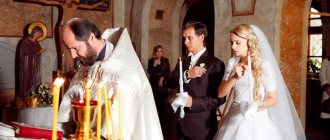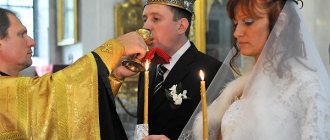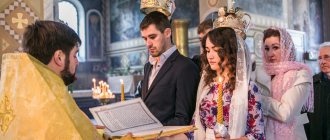First, you should know that there are several options for Marriage Blessings.
- Sacrament of wedding for newlyweds,
- The sacrament of marriage for people getting married for the second time,
- The sacrament of a wedding is for mature, married people whose home is already filled with children's laughter from their grandchildren.
We will not consider each option separately, but will consider the “Sacrament of Wedding for newlyweds,” which is fundamental to the other two options.
The differences between the other two and the fundamental one are logical. For newcomers and for people who have been married, who already have a lot of experience behind them, the “Betrothal” is omitted, and prayers are read completely different than for the young, they are replaced by a petition for forgiveness of sins, for old age, for their generation - at the discretion of the priest , but I came across different practices in the missals, in one version the laying of crowns was not used, in the second it was used - this will not be a mistake, in this case the most important and unchangeable is the so-called wedding formula: “Lord Our God, I crown with glory and honor” . Therefore, trust the literacy of the priests in your parish.
Cost of the sacrament
The cost of the ceremony is quite scrupulous. On the one hand, a reasonable question arises: how can one even charge for God’s grace? What if the spouses do not have enough funds to pay in full, it turns out that they cannot count on God’s blessing?
However, on the other hand, the church is considered the same organization that provides services, albeit in the spiritual sphere. And, as you know, every service requires payment - no one asks why pay for utilities or the Internet.
The difference in pricing policy largely depends on the region of residence and even temples located in the same city.
The wedding price listed below is a guideline as prices are constantly being adjusted.
Help: You can find out the exact amount of payment by contacting the chosen temple for the ceremony.
For example, in the capital the initial cost is about 10 thousand rubles. In St. Petersburg, similar amounts are established.
So, we will consider the complete Sacrament of Marriage with betrothal
The sacrament can be performed both with and without a choir, with and without a deacon, with and without a sexton - in other words, one priest can perform a sacrament, but with a choir and a deacon it is much more solemn and prayerful.
The young people stand facing the Altar
First of all, the young people stand at the entrance of the temple, facing the altar, or in the back of the temple at the door, the groom on the right side, the bride on the left. The church will tell you in advance where the sacrament will begin; both options will not be a mistake, but for the convenience of those getting married and guests, it is most practical to begin the activities in the church itself.
Everything has already been prepared for the meeting of the newlyweds in the Temple, some nuances remain
A table was prepared in advance in the middle of the temple, a long towel in front of it, the priest put the rings of the bride and groom on the throne on a special plate, and next to them on the throne there were icons of the Savior and the Mother of God - which on the throne are consecrated in this way: the Royal Doors are opened, included in the whole world, the priest brings out the Gospel and the Cross and places them on the prepared table. He approaches the wedding couple, blesses them, lights candles and hands them.
Everyday
The censer makes a cross incense. Here, at the discretion of a particular priest, censing may not be performed, but not only the censing of those getting married, but also the “small censing of the temple” may be performed. In this case it is not critical.
Next begins "Betrothal"
Priest: Blessed be our God always: Now and ever and unto ages of ages.
— Chorus or people: Amen
The priest calls those present at the wedding to prayer and begins to pray himself, exclaiming:
Let us pray to the Lord in peace!
- Chorus or people: Lord, have mercy!
It is important to pray for everyone ahead
The people stand, not looking down, but opening their ears, listening to every word said by the priest, which is currently addressed to the people, at the end of each petition we hear “Let us pray to the Lord” - this is a direct appeal to the people about prayer.
The priest repeatedly proclaims various petitions publicly
The priest, pronouncing the litany, pronounces it in the rhythm generally accepted for the church, cheerfully, without irritating the ears of those praying, but not monotonously, in order not to lose human attention
Let us pray to the Lord for peace from above and for the salvation of our souls!
—— Choir or people: Lord, have mercy!
For the peace of the whole world, the Prosperity of the Holy Churches of God and the Unity of all, let us pray to the Lord!
- Chorus or people: Lord, have mercy!
For this Holy Temple, let us pray to the Lord with Faith and Reverence for those who descend into it!
—— Choir or people: Lord, have mercy!
The litany itself is very similar to the peaceful one, but on the occasion of betrothal, special petitions are added for the young spouses.
We will not consider some of the petitions, since the main task is to reveal the meaning of the sacrament, and not to scrutinize the entire rite.
For the Servant of God, the name of the groom, and the servant of God, the name of the bride, who are now engaged to each other and for their salvation, let us pray to the Lord!
—— Choir or people: Lord, have mercy!
Let us pray to the Lord for the possibility of giving them a child to be adopted into the family and for all the petitions that lead to salvation!
—— Choir or people: Lord, have mercy!
Some petitions, for example, in the rite of the sacrament of marriage, intended for people, so to speak, who have been married for thirty years, will be different, because if those getting married are 65 years old, then what kind of childbearing should they ask God for, they are replaced by petitions necessary for a specific age or omitted altogether. This was done in order not to throw vain petitions before God and not to lead those praying into misunderstanding.
Let us pray to the Lord for more perfect love, more peace, and help to be sent to them!
Let us pray to the Lord for their continued unanimity and stronger faith!
Let us pray to the Lord for their continued unanimity and firm faith!
For the Lord our God will grant them an honest marriage and an undefiled bed, let us pray to the Lord!
Let us pray to the Lord for deliverance from all sorrows of anger and need!
Intercede, Save, Have Mercy and preserve us, O God, with Your Grace!
The last two petitions that we are considering here affect the interests of not only the newlyweds, but also all the people present and praying.
Next, the priest prays a short prayer, after which he goes to the altar, takes the rings and presents them to the betrothed
He blesses the bride and groom in turn with a cross, holding a ring in the same hand, puts it lightly on the finger of each of them, then changes each other’s rings and says: “In the name of the Father and the Son and the Holy Spirit, Amen.”
After which the newlyweds put rings on each other in the usual way, that is, so that the ring does not fall
The priest reads prayers in which the names of ancient Christians are mentioned, from the Old Testament, historical events that are found in the Bible and associated with marriage and the Blessing of the Lord of People for betrothal are recalled.
After this, the priest proclaims a short litany
The wedding ceremony: positive and negative sides
It is necessary to pay attention to the fact that churches contrast the spiritual life of a consumer society with marriage according to the established traditions of Orthodoxy.
The family in the life of every believer is the personification of a stronghold, which provides:
- mutual support during numerous everyday difficulties;
- working together on your spiritual development;
- possible education of each other;
- the joint joy of their endless love, which, moreover, is blessed by God.
Note: the married spouse is a companion for life.
Without exception, all the spiritual forces acquired by the family are transferred not only to social, but even to state activities.
The Sacrament of Wedding itself begins
After the Betrothal, the very rite of the Sacrament of Wedding begins, when the newlyweds take each other by the right hands, since if they were greeting, the priest covers their hands with stole, puts his hand on top and begins to solemnly proclaim verses from Psalm 137, and at this time the priest begins lead the couple from the end of the temple to the middle. If the betrothal took place outside the temple, then the priest takes the newlyweds also to the middle of the temple, they stop at the spread towel and do not step on it until the time comes. The guests are also moving forward.
Blessed are all who fear the Lord
- Chorus or people: Glory to Thee, our God, Glory to Thee!
Those who walk in his ways
- Chorus or people: Glory to Thee, our God, Glory to Thee!
To bear the fruits of your labors
- Chorus or people: Glory to Thee, our God, Glory to Thee!
We will not consider all the poems, although there are not many of them; if desired, I will tell those who are interested individually.
After the newlyweds stopped at the towel, the verses of the psalm ended
The priest turns to the newlyweds and says an instructive word; of course, the priest had already met with the newlyweds before organizing the sacrament, checked their intentions, prepared them for the sacrament, a lot of things were said. But now is a special time, when the time has come for the sacrament to be performed, when a person must penetrate into the meaning of the sacrament, feel Divine Grace, consciously approaching it and listening to every word spoken by the priest in prayer. And the priest, understanding this, must choose words that would help the sacrament be accomplished with fervent prayer, taking into account not only the newlyweds, but also those present, because when the sacrament is performed and everyone is counting flies, the sacrament, of course, has Grace, but if everyone will listen and pray, there will be greater grace, because there are more people praying and their prayer is not formal, but purely.
After this, the priest addresses the newlyweds, each one separately.
Asking the first groom: “Have you, (name of the Groom), taken a good and spontaneous will and a strong thought to take this (name of the Bride) into your wife, right here before you?”
Just in case, let me explain, in the presented question to the groom, the priest asks whether he has a voluntary will and whether he agrees and whether it is his independent decision to take the bride as his wife.
(A small digression: this question is relevant only for newlyweds and newlyweds; for the rite of Blessing for the Marriage of elderly people, the priest does not ask such questions, for obvious reasons).
The groom answers: “Imam, Honest Father.”
By such a response from the groom it is meant that he has a strong, good, independent will to take in himself the bride who is standing next to him.
The second question from the priest to the groom: “Did you make a promise to another bride?”
The groom replies: “I didn’t promise, Honest Father.”
Similar questions will be asked to the bride, and she will give similar answers.
After which the priest again asks the newlyweds to join their right hands, covers them with the stole and encourages the newlyweds to move forward so that they stand on the towel
At the same time, the priest proclaims: “Blessed is the Kingdom of the Father and the Son and the Holy Spirit, now and ever and unto ages of ages.”
Choir: Amen
The Sacrament of the Marriage begins with a great litany, in which, as before, by default it calls on all those standing and praying to gather their thoughts and attention, listening to and heeding each petition.
I would like to highlight the special petitions of this litany:
Let us pray to the Lord that this marriage may be blessed, as it was in the can of Galilee!
For the benefit of chastity and the fruit of the womb, let us pray to the Lord!
For the vision of sons and daughters to rejoice in them, let us pray to the Lord!
Let us pray to the Lord that they may be granted happiness and undisturbed abiding!
Let us pray to the Lord to grant them and us all the requests for salvation!
Each litany contains petitions aimed not only at those getting married, but also petitions for all upcoming
Let us pray to the Lord that we too may be delivered from all sorrow, anger and need!
Again, we will not consider all requests.
After which the priest exclaims to the people: “Let us pray to the Lord!”, and everyone gathers their thoughts again, and the prayer begins.
The priest begins to pray with great attention
There are 3 large, interesting, deep prayers ahead, in which the forefathers from the Old Testament are again remembered, who also chose the family path and gave birth to many children, the events of the blessing of marriage by the Lord himself in the New Testament, special petitions to the Lord for the upcoming newlyweds: a peaceful life, longevity, chastity , love in the bond of peace, continuation of the race, to give into their home all good things with abundance, so that they will help from this abundance to others in need, and many other petitions and events associated with the human race are mentioned in these special prayers, warming the soul of those praying and preparing them to the culmination of the events of the sacrament of Marriage.
Crowns
At the end of the prayers, the priest takes the crown, on which the Savior is depicted, turns his face to the newlyweds: “The servant of God (says the name of the groom) is married to the servant of God (says the name of the bride) in the name of the Father and the Son and the Holy Spirit, Amen.”
At the same time, he blesses the bride and groom with a crown, both of them, and puts the crown on the groom.
Afterwards, the priest takes the crown on which the Mother of God is depicted, carries out similar actions, first calling the name of the bride and blessing her first, after which he puts the crown on her.
The most important moment of the wedding
Finally, the most important moment, for which everything that happened previously was a preparation, for which all the prayers were offered, for which everyone gathered, the priest begins to officiate.
Turning to God towards the altar, the priest raises his hands and says publicly: “Lord Our God, I crown with Glory and Honor.”
He turns and blesses the newlyweds, and this is done three times, after this moment the newlyweds are already married, but the sacrament does not end there, there are no less significant actions and prayers ahead, which have an important meaning.
Immediately the priest solemnly proclaims the prokeimenon, which clearly expresses the meaning of the holiday
The prokeimenon is a verse from a psalm that is read by the reader or clergyman before reading the Apostle and the Gospel. The prokeimenon reflects the meaning of a holiday or event.
For example, the prokeimenon at the Wedding:
Prokeimenon voice 8: I placed crowns of honorable stones on their heads, asking for life from you, and you gave it to them.
The Prokeimenon together with the verse is beautifully sung by the priest and repeated by the choir.
Solemn reading of the Apostle and the Gospel (the passages are very deep in meaning, and it is important to listen to them)
The following is the message of the Holy Apostle Paul. The Russian Orthodox Church received a very valuable heritage, which we inherited from the apostles; the apostles taught people after the Holy Spirit descended on them, fulfilling the Will of God, and with their instructions they spoke much of the wisdom of God. Thus, the Apostle Paul addressed the people with messages on various topics, including family ones.
It is important to understand that reading the Apostle and the Gospel is not prayer, these are grains of Divine wisdom that have come down to our time, and therefore, when such readings are read, those present listen with attention and are surprised.
Not literally, but I will still try to convey the meaning of the apostolic reading, which is read at the Wedding. It says that wives should listen to their husbands in everything, as the Lord, since the husband is the head of the wife, just as Christ is the Head of the Church and that is the savior of the body. Just as the Church submits to Christ, so do wives to their husbands in everything. Husbands, love your wives, just as Christ loved the church and gave himself up for it. Husbands, love your wives as you love yourself and your body; he who loves his wife loves himself. And whoever hates his body, but nourishes and warms it. So a man will leave his father and mother and be united to his wife, and the two will become one flesh. This is a great mystery. Let the husband love his wife as himself, and let the wife respect and be afraid of offending her husband. The Apostle clearly displays the basic principles on which family life is built: the wife marries her husband, and the husband is the head of the family, the wife respects her husband and is afraid of offending him, the husband loves his wife so much that his love overcomes all mutual misunderstandings and other situations, which can throw a person off balance. In fact, the apostle thinks much deeper here, but this is a separate topic for discussion.
After the end of the apostolic reading, the priest begins to read the Gospel; at the Wedding, the Church reads the Gospel of John. I remember the Gospel event, the first miracle that the Lord performed. The Lord and the Mother of God were invited to a marriage in Cana of Galilee (that was the name of a small city in Israel), and the wine ran out at the celebration. The Lord ordered the containers to be filled with water, and the waterpots were filled with water, and the Lord turned the water into wine. The master of the feast was surprised at the extraordinary taste of the wine. And everyone was surprised. And then his disciples believed in him.
And this event became for people not only a miracle of turning water into wine, but also a blessing of marriage.
Proclamation of the Litany
After reading the Gospel, the priest proclaims a litany, but now not a peaceful one, but an intense one; the litany received this name because the petitions are structured in such a way that they cannot be called anything other than an intense prayer; the litany begins:
We say everything with all our hearts and with all our thoughts.
Further, petition after petition strengthens the prayer, and in the middle of the litany, instead of “Lord, have mercy!”, the choir or people respond: “Give, Lord!”
After the end of the litany, the people sing the prayer “Our Father” and the newlyweds drink wine from the same cup
The priest reads a prayer for the consecration of a common cup of wine, turns to the newlyweds, and they take turns drinking the ladle of wine, like the cup that they will carry together throughout their lives with joys and sorrows.
The connection of the right hands of the newlyweds and the triple movement of the priest and the newlyweds supported by them around the central icon
After the cup has been drained, the priest again asks the newlyweds to join their right hands, he covers their hands with the stole, grabs them firmly with his hand, holds a cross in the other hand and leads them to the central icon, making a circle around it, while the choir or priest sings troparia The circumambulation of the central icon is performed three times.
We sing on the fifth voice (the designation of the voice means tone and motive)
The priest proclaims the first part of the troparion, the choir finishes singing
Isaiah, Rejoice , I had a virgin with child and gave birth to a son, Immanuel, God and man, the east is his name, which is magnified, We please the Virgin.
Let's sing on Tone Seven:
Holy martyrs, who suffered well and were crowned, pray to the Lord to have mercy on our souls!
Glory to Thee, Christ Our God , the praise of the Apostles, the joy of the martyrs, their preaching, the Trinity is consubstantial.
After the third circle we return to our seats, the priest turns to the newlyweds and takes off their crowns one by one
To the groom
He turns to the groom and takes off his crown: “Be magnified, O bridegroom, like Abramam, and blessed, like Isaac, and multiplied, like Jacob, walk in peace, and do the commandments of God in righteousness.”
For the bride
The priest turns to the bride and removes the crown from her: “And you, bride, have been magnified like Sarah, and you have rejoiced like Rebekah, and you have multiplied like Rachel, rejoicing over your husband, keeping the limits of the law for God’s sake.”
The priest, speaking to the bride and groom, mentions the names, but in order to understand the meaning and depth of what was said, the reader is recommended to turn to the Old Testament, for example, in the book “The Law of God”, the historical events associated with these names are very briefly outlined - please , study on your own.
Next, the priest reads several prayers facing the altar. He ascends to the pulpit and from the pulpit performs the dismissal
The priest solemnly proclaims
He proclaims: “Grant a prosperous and peaceful life, health and salvation and good haste in everything, O Lord, to those now united in a marriage of communion (names the bride and groom) and preserve them for many and prosperous years!”
The choir sings for many years
The choir or priest begins to sing: “Many, many, many, many, many years, many years, many years, save, Lord, grant them, Lord, many years, many years, many years, many years!”
Other features of the wedding ceremony
Few people know, but various signs are associated with the type of ritual in question. For example, if during the sacrament, one of the spouses’ candle goes out or a ring falls off, then this is a sign of a bad sign.
This is generally considered a harbinger of an unhappy marriage.
Among other signs: the one who was the first to step on the spread towel will be considered the head of the family.
Another sign indicates a ban on performing the ceremony in May, otherwise, according to the beliefs of ancestors, the family will suffer all their lives.
Help: churches do not accept such signs, because, in their opinion, this is all nothing more than nonsense. However, there are those who attach special importance to them.











